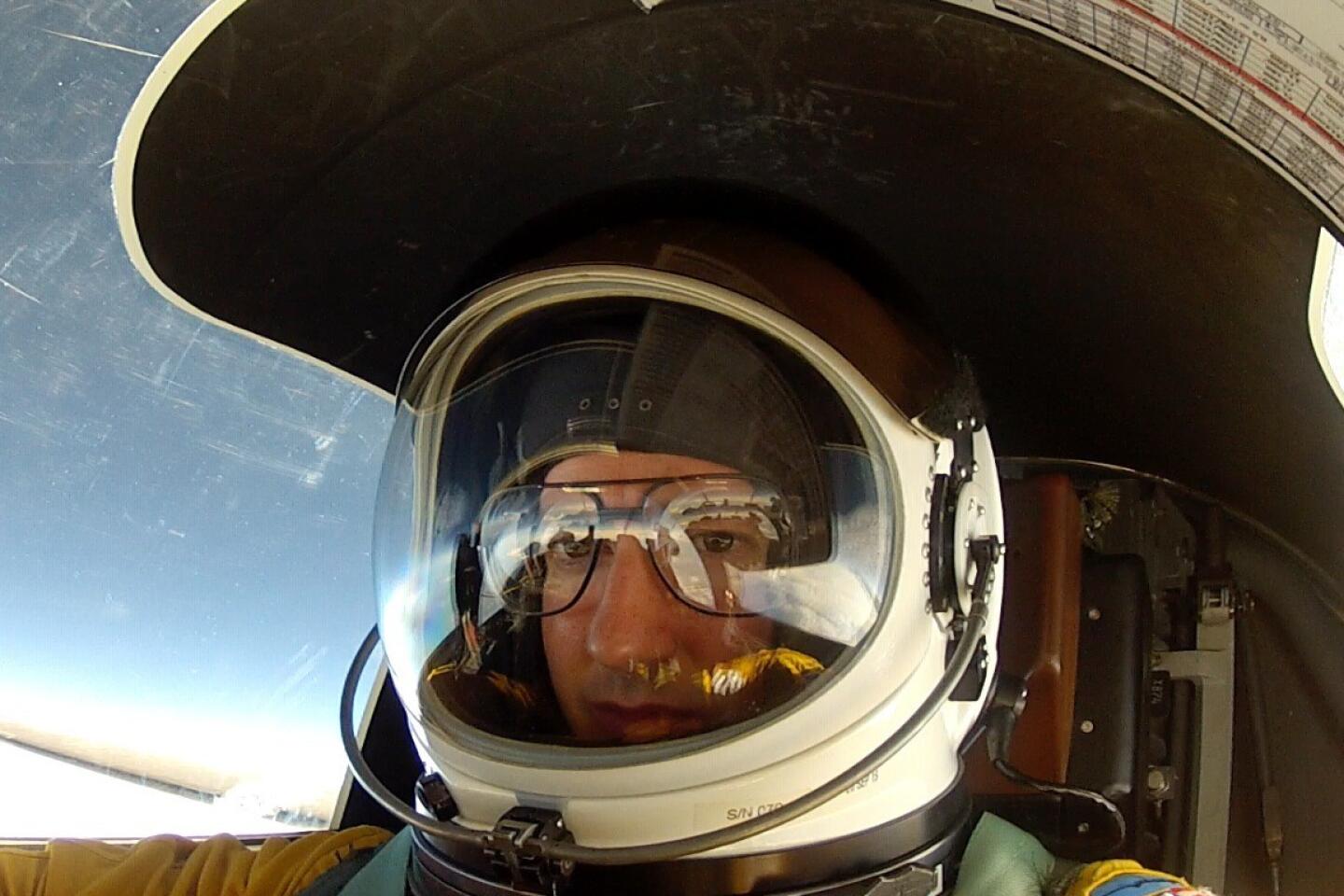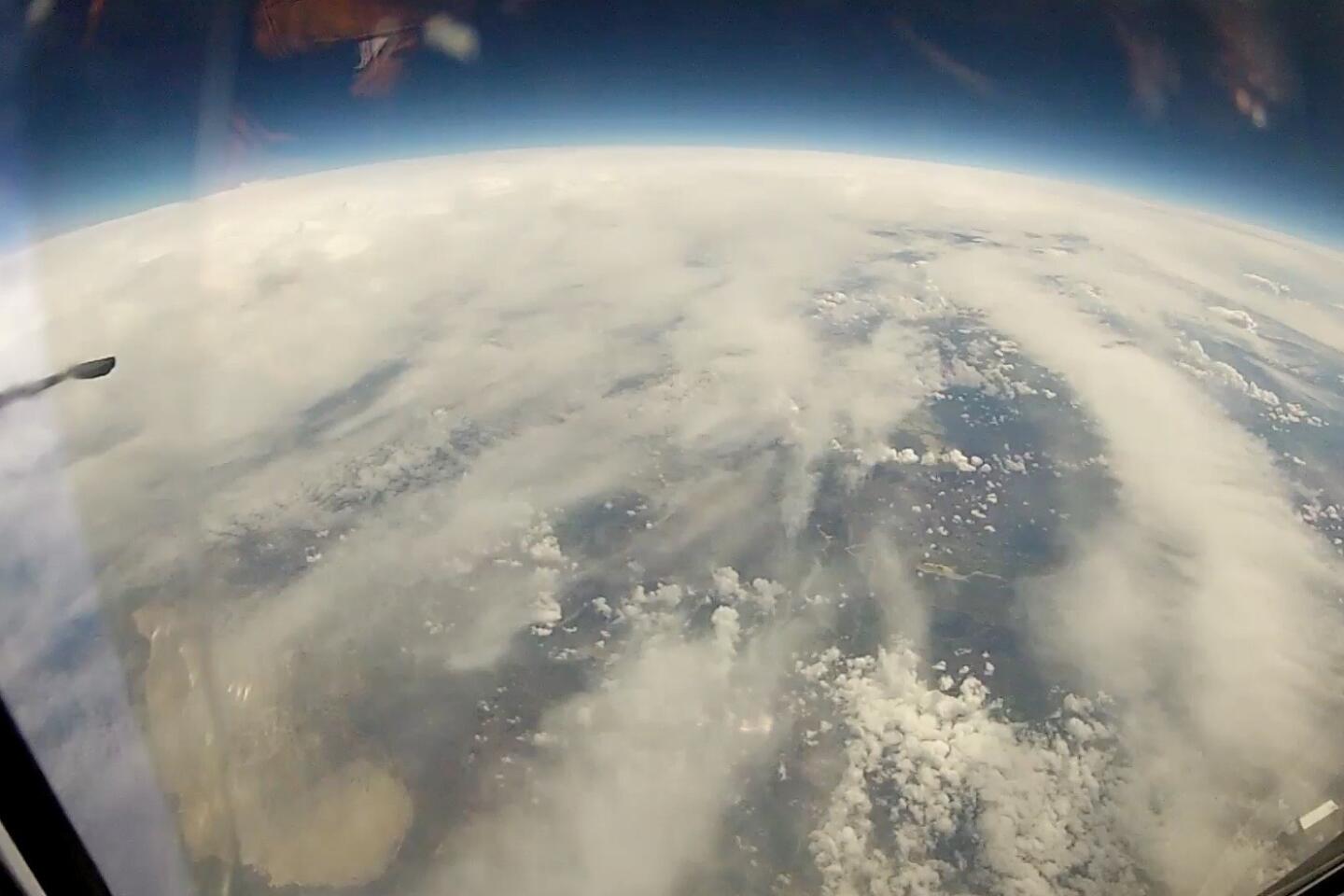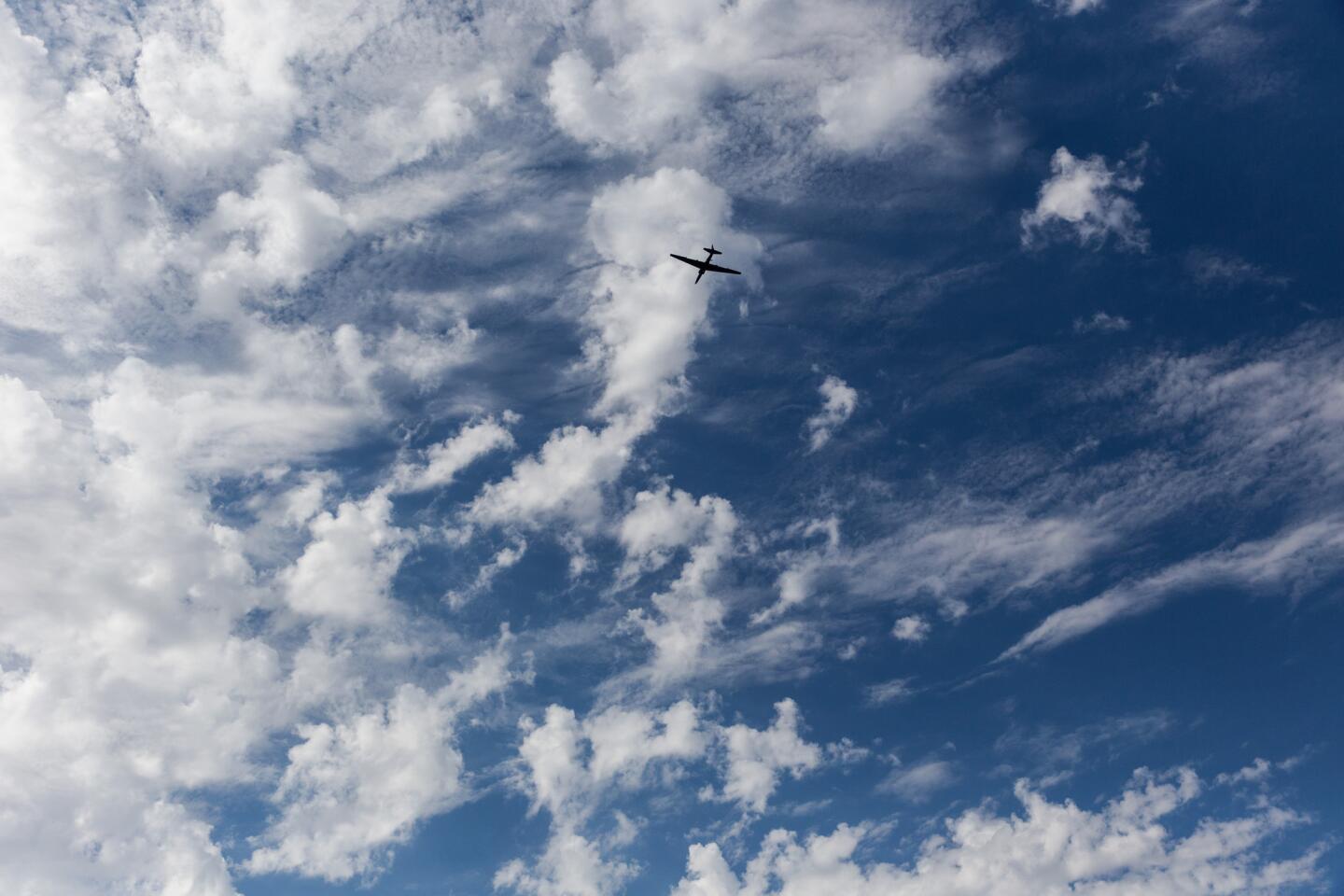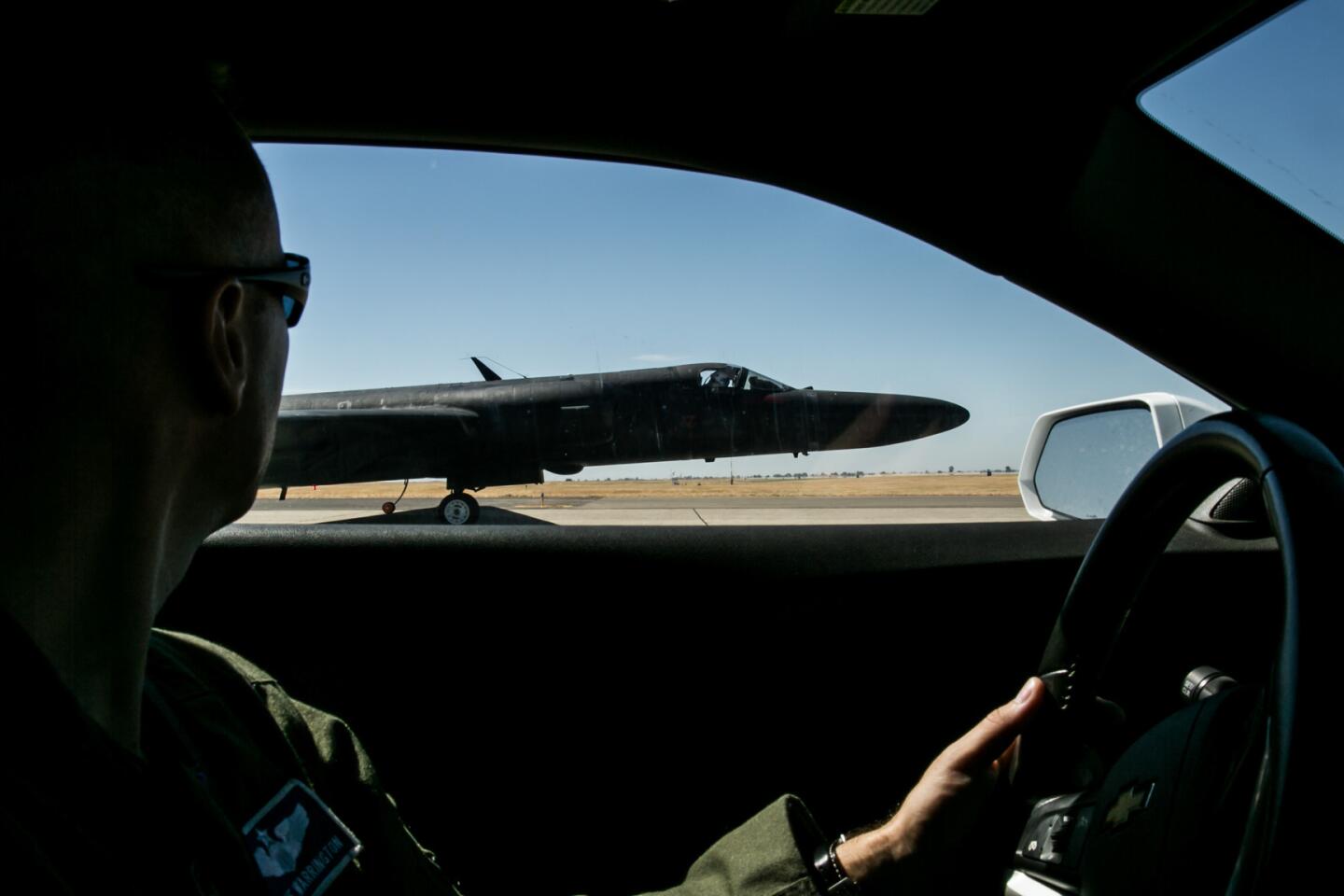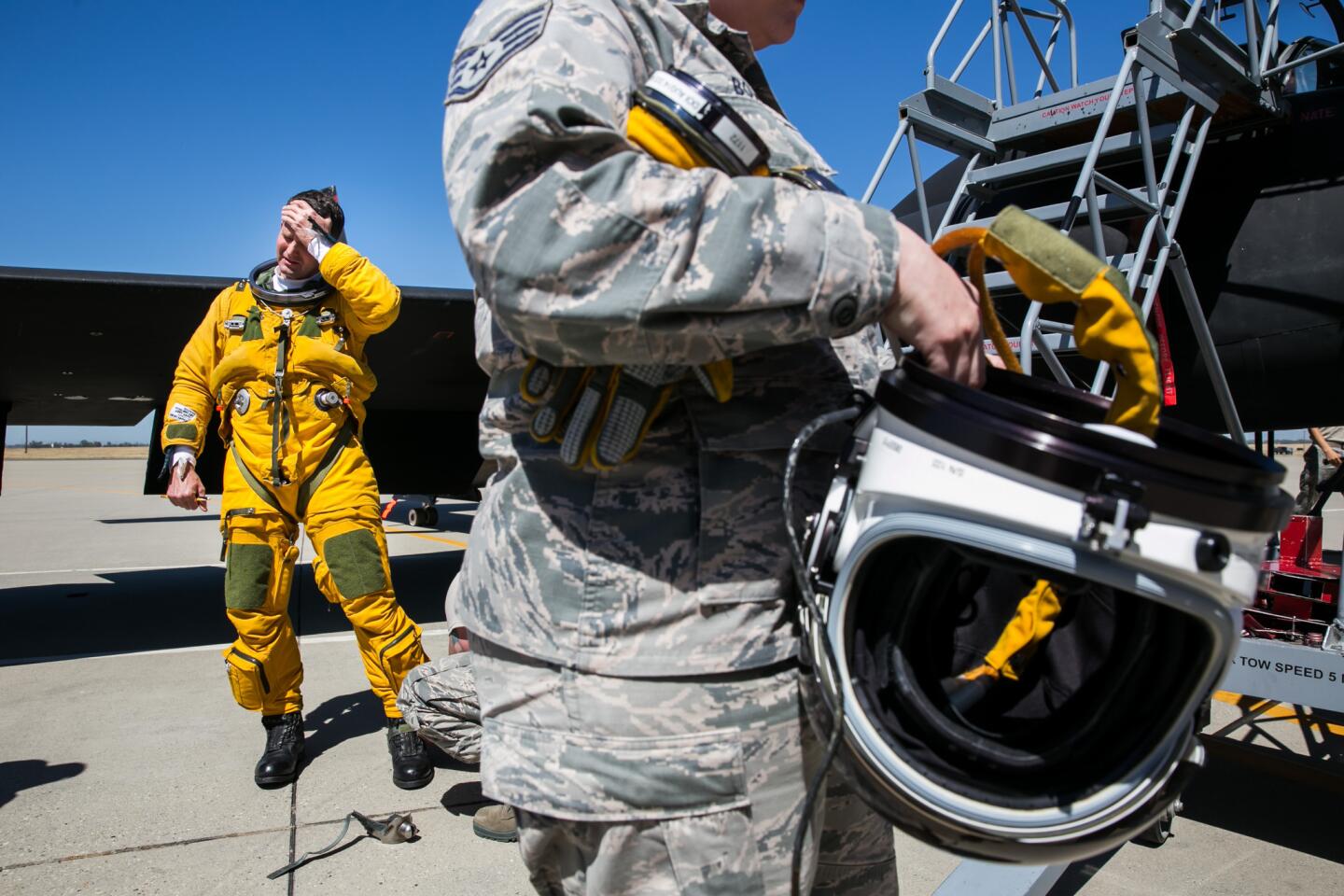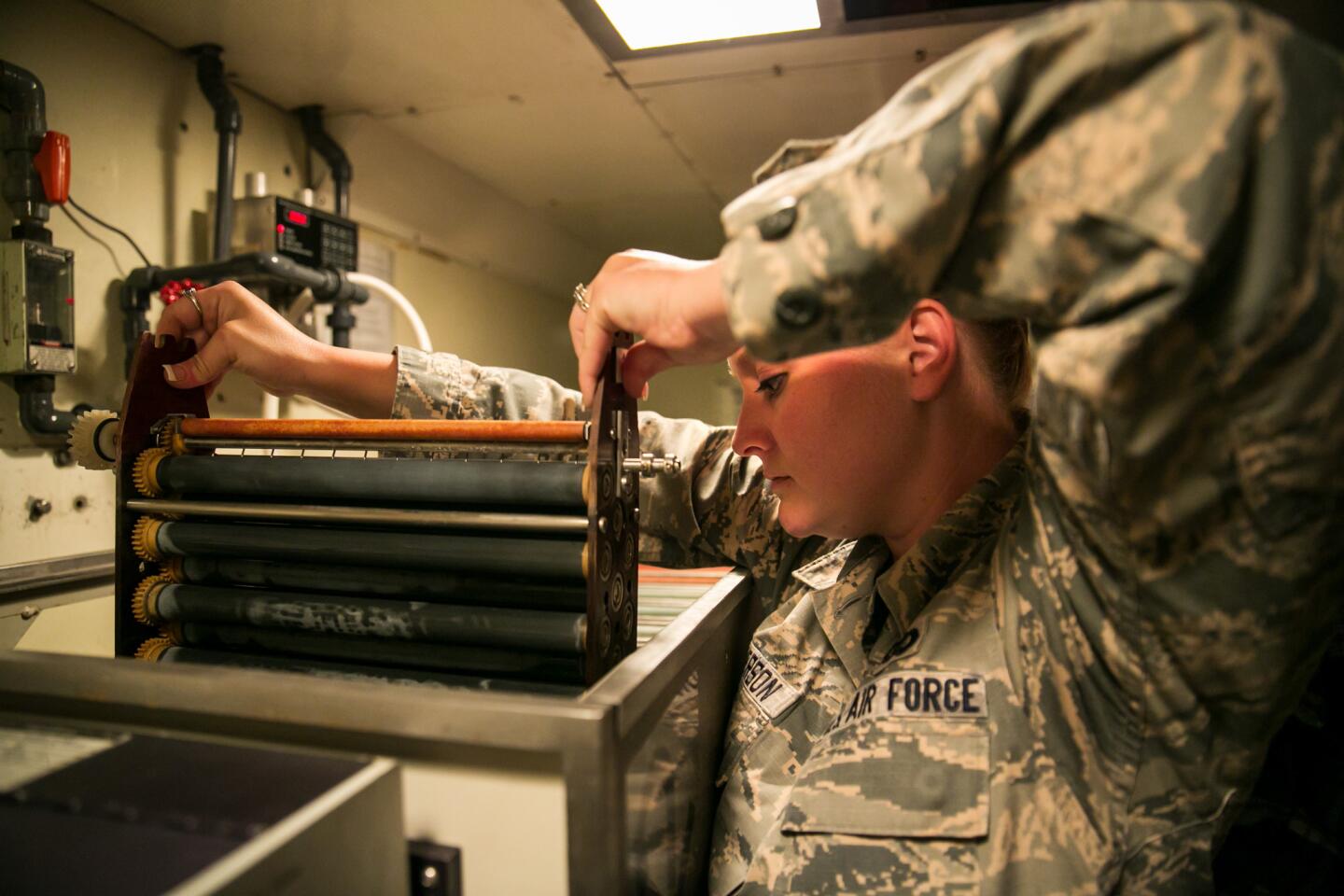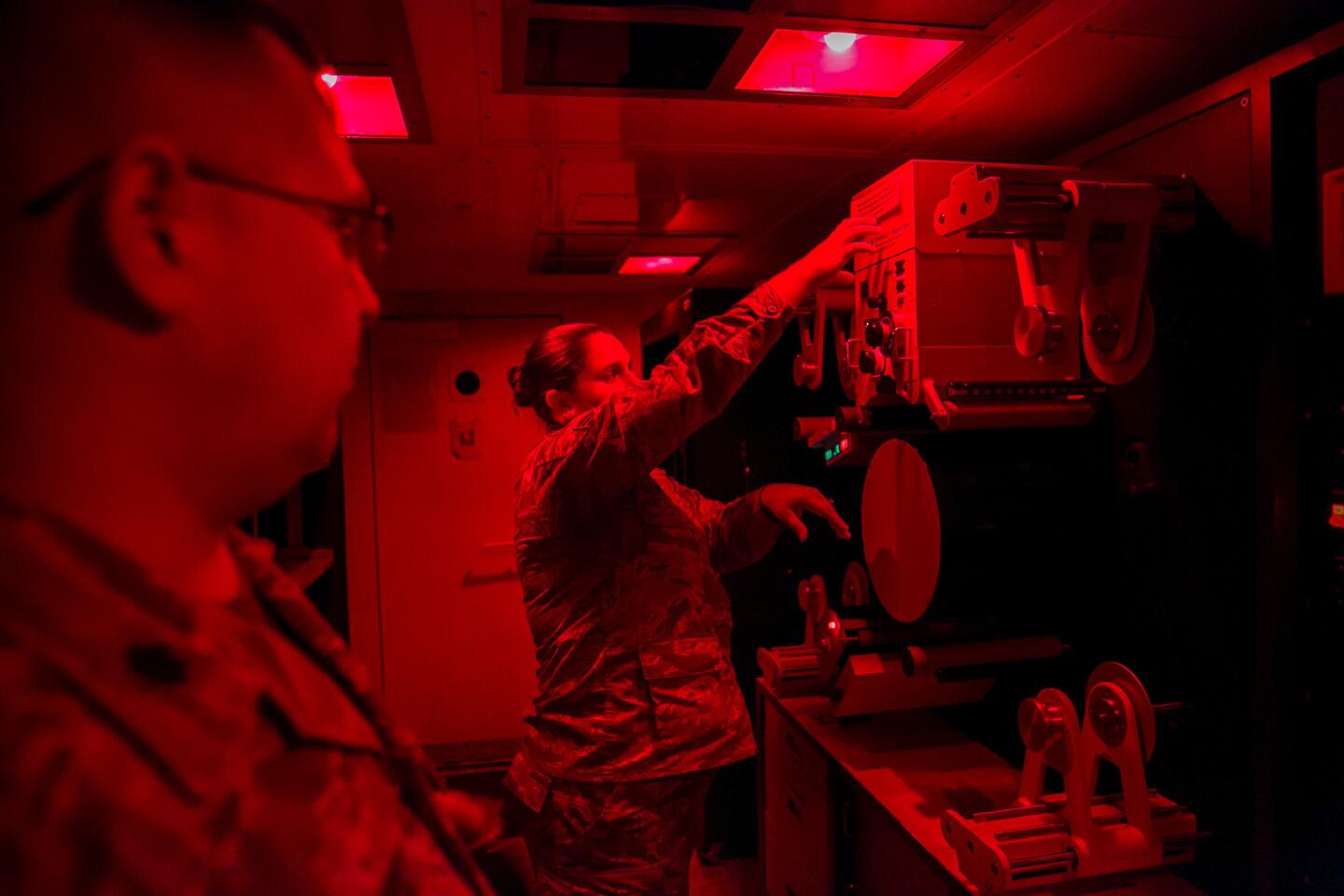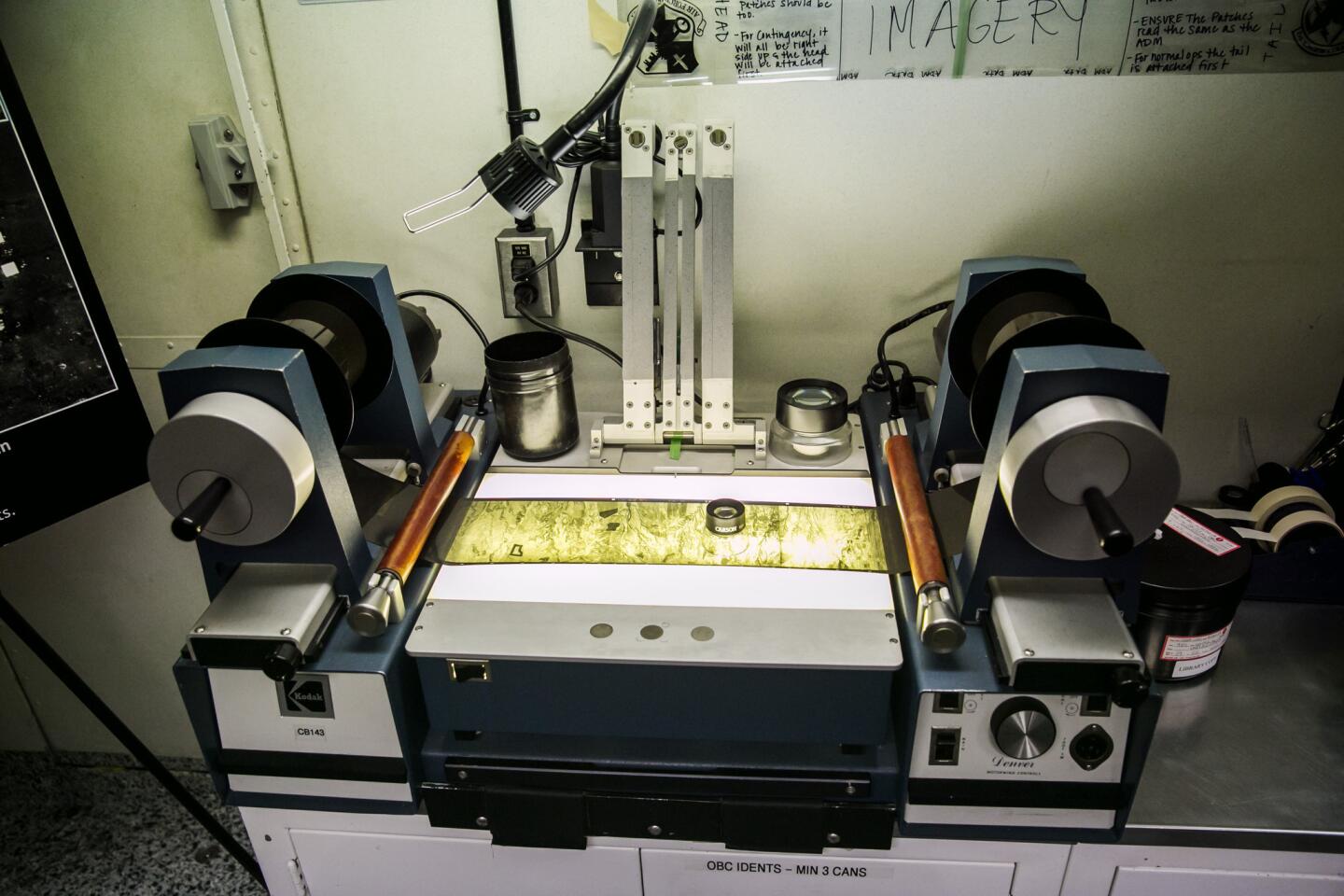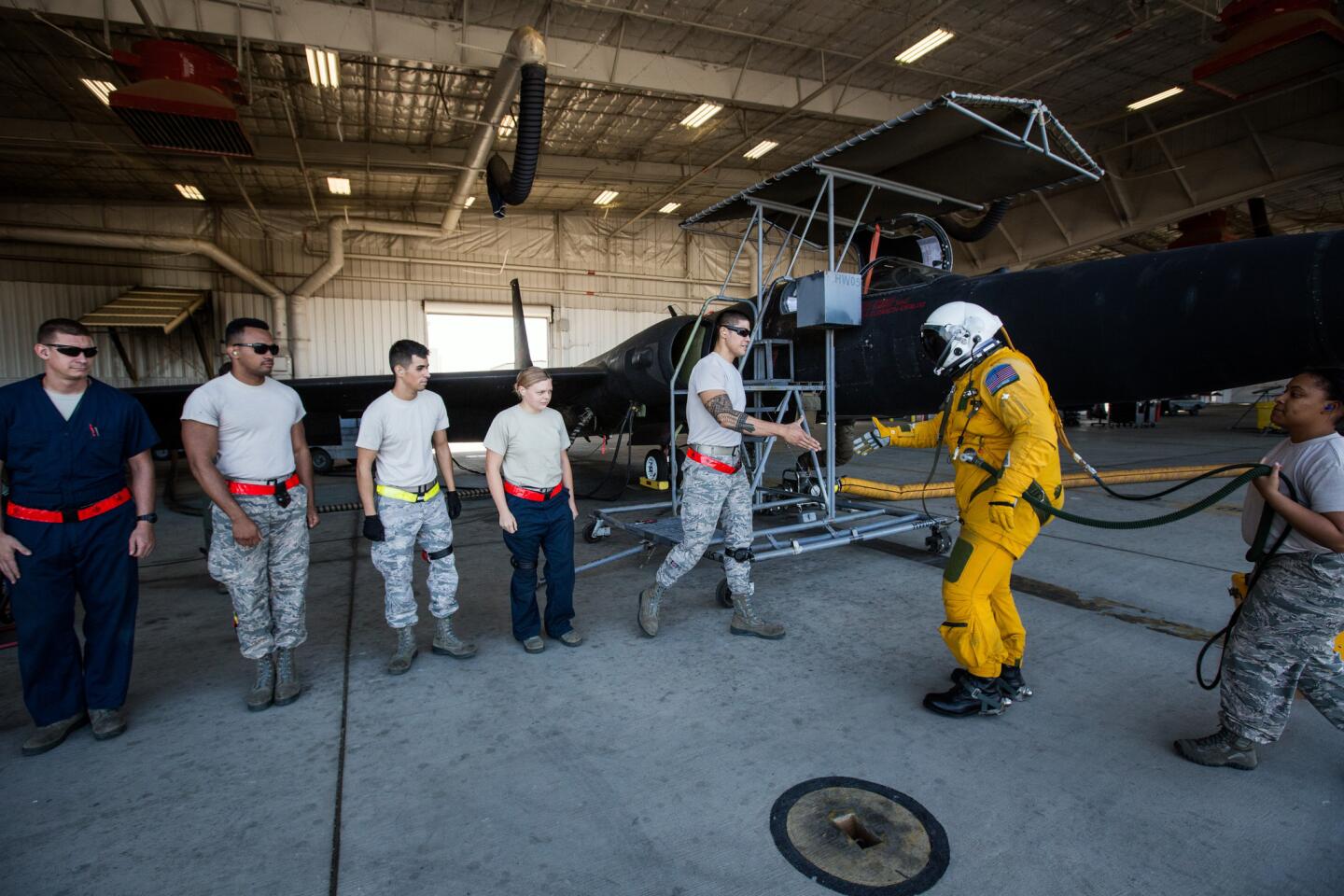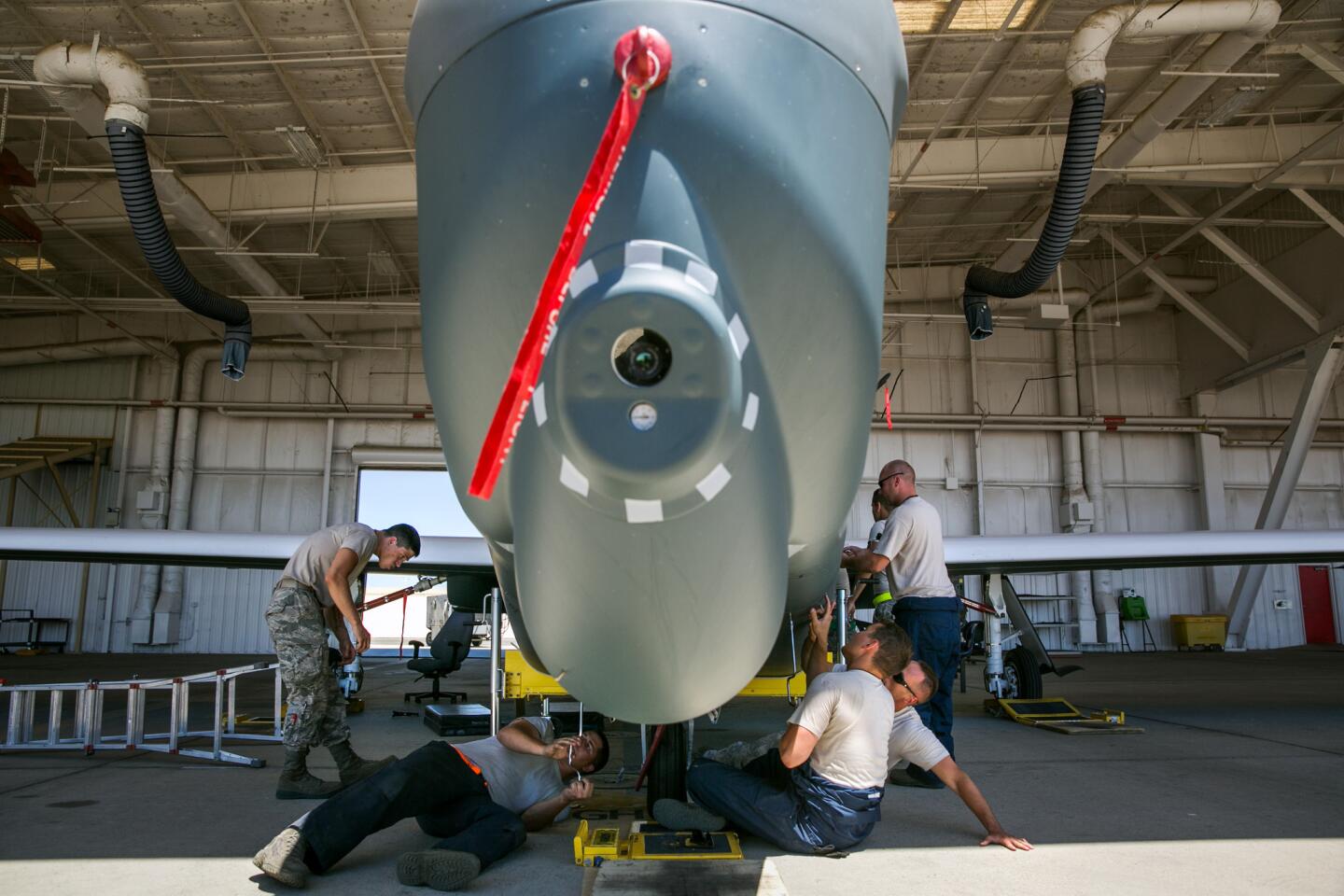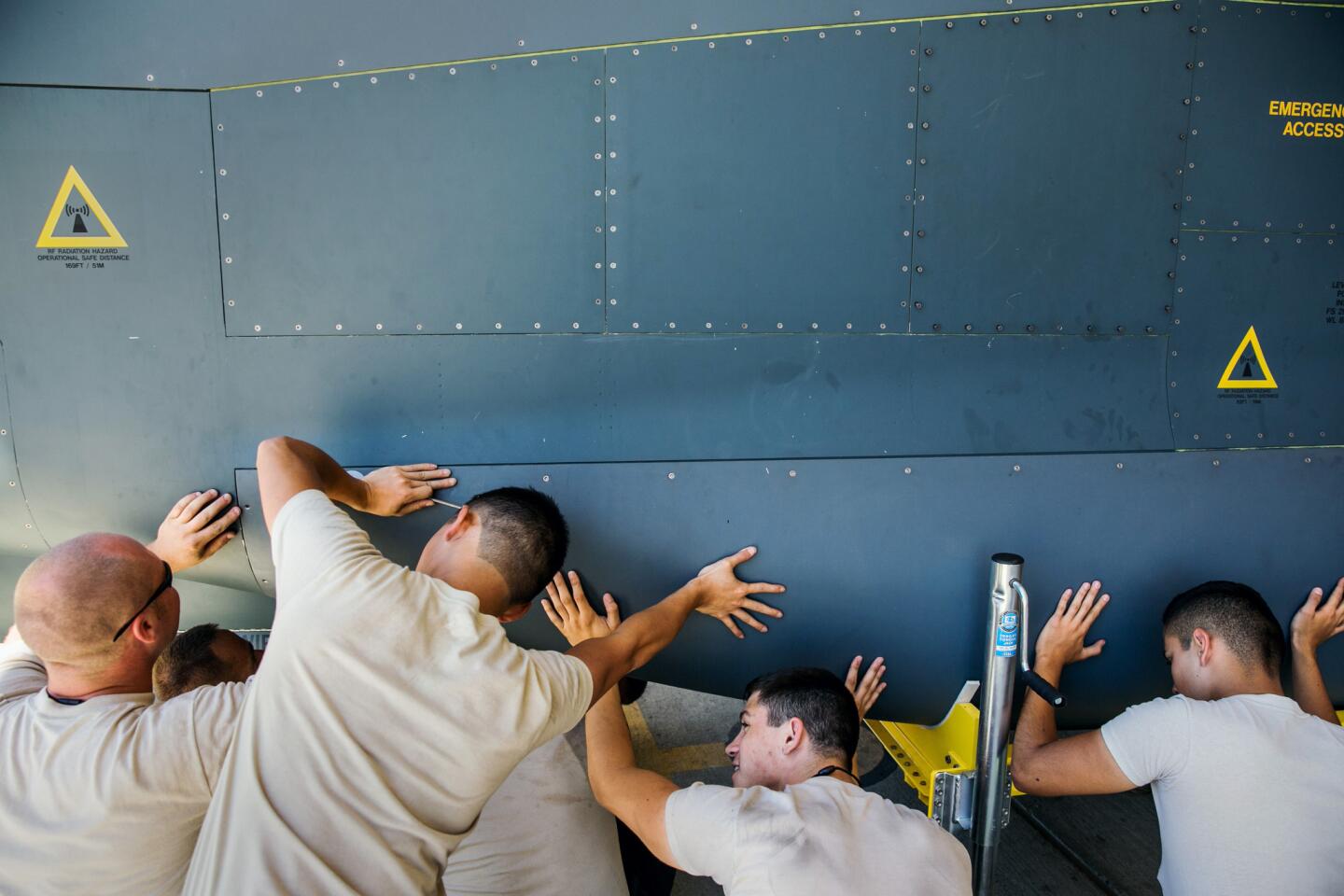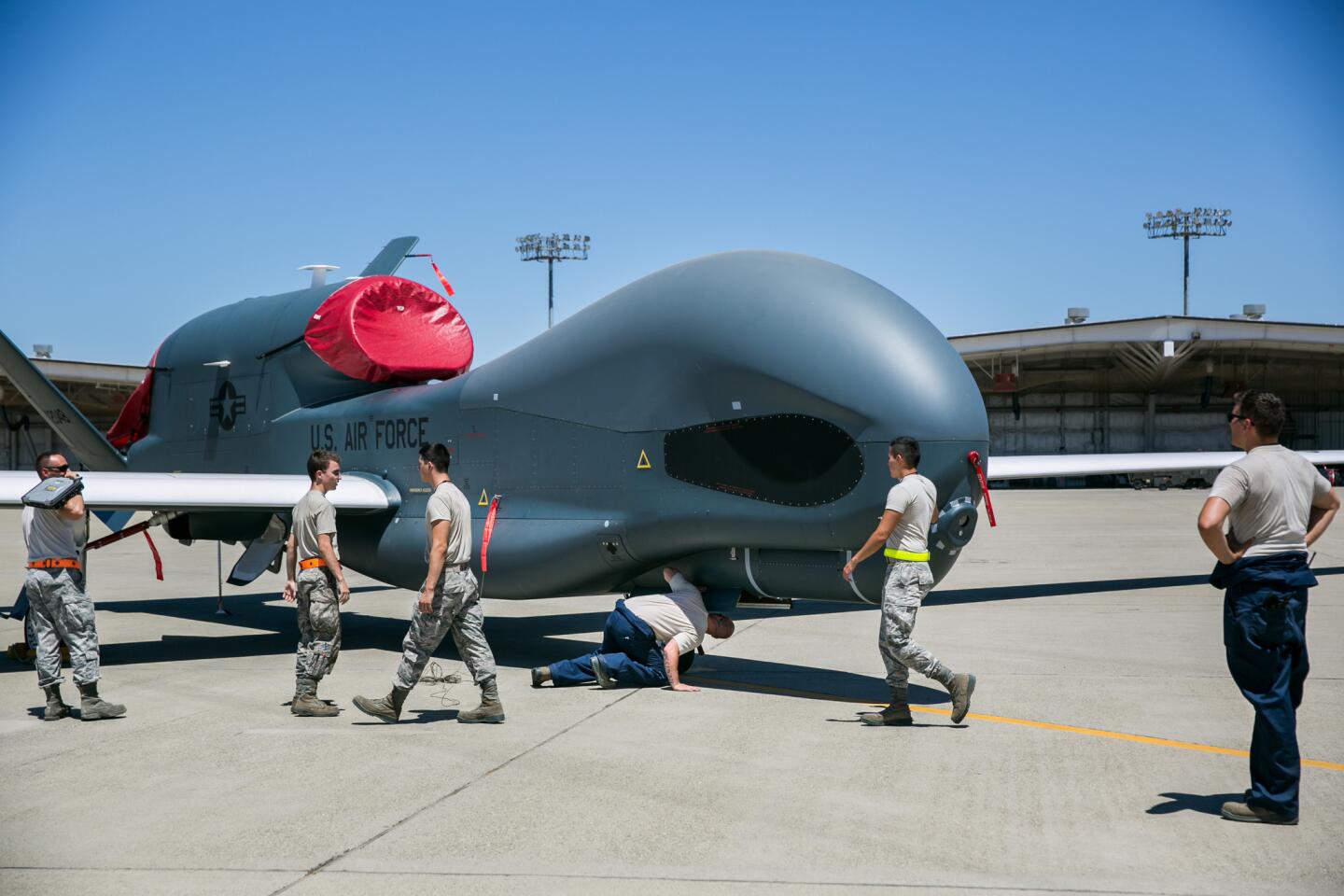Great Read: U-2 spy plane pilot lives on the edge – of space, danger and obsolescence
- Share via
Reporting from Beale Air Force Base, Calif. — Maj. David Brill squeezes into a bulky yellow spacesuit, lowers a fishbowl-size helmet onto his head and readies himself for a flight into the stratosphere.
In an hour, he will roar aloft in a U-2, the iconic single-seat spy plane — capable of flying to 70,000 feet, or more than 13 miles high — first built in the early Cold War.
At that altitude, the only humans higher are in the International Space Station. The curving Earth appears like a ghostly vision below and the blackness of outer space looms overhead.
“There are these moments when I can see the sun over my left shoulder and the moon over my right,” said Brill, 36. “There aren’t a lot of people that get to experience that.”
A van takes Brill to the flight line, where he steps into the summer sun, clambers up a stair ladder and stuffs himself into the snug cockpit. His 6-foot frame fills up every bit of space as he tugs down on the canopy and snaps it shut.
He looks down the runaway and sees the inexorable future looming to one side: two of the Global Hawk drones that are scheduled to replace America’s fleet of 33 U-2s.
SIGN UP for the free Great Reads newsletter >>
The U.S. military has spent the last decade amassing more than 7,000 surveillance drones. Some the size of birds are used by infantry to see what’s over a ridge. Others as large as jetliners can spy on wide areas for up to 30 hours at a time.
With robotic surveillance power like this, the military decided to retire U-2s after more than 60 years in service. The spy planes will be phased out starting in 2018.
Despite this, U-2s are being flown more hours than they have since the end of the Cold War. Now, rather than capture vital intelligence in the Soviet Union, Brill and nearly 200 other U-2 pilots are doing it for the fight against Islamic State.
Without U.S. ground troops in Iraq and Syria, commanders rely on airborne surveillance more than ever before. At any given moment, a U-2 — often two — is in the air, zeroing in on militant bomb-making facilities in dense cities or snooping on fighters’ communications to pinpoint command hubs.
::
Brill grew up in Seattle, home to jet-building operations for Boeing Co., the largest aircraft manufacturer in the country. His father had a stint working as a technician on 727s after serving as an Army paratrooper.
When Brill was 17, his father bought him a one-hour flying lesson on a single-engine Cessna prop plane.
“It was cloudy, turbulent and bumpy,” he said. “It was thrilling.”
Brill was hooked. He visited aviation museums and devoured books like “The Right Stuff,” Tom Wolfe’s bestseller — later a movie — about test pilots and the early days of the space program. He was inspired by daring pilots who took risks and showed those who follow them how to avoid costly mistakes — like lead climbers who blaze a path up a mountain peak.
He studied aerospace engineering at Arizona State University. In 2002, he joined the Air Force and became an F-15 fighter pilot.
During the Iraq war, though, the military had plenty of fighter pilots. What commanders needed was information. There was high demand for aerial surveillance of what was happening on the ground. Brill ended up flying more than 100 missions in a MC-12 reconnaissance plane over cities like Baghdad and Mosul, helping ground forces raid enemy compounds and avoid ambushes.
Saving troops’ lives “opened my eyes to the value of ISR,” he said, using military jargon for intelligence, surveillance and reconnaissance. When his tour ended in 2011, he applied to the U-2 program.
All hopeful pilots must have 1,200 hours of flying time. Brill had that. They generally have flown more than one type of aircraft. Brill had. And they must have stellar records and a wing commander’s recommendation even to get an interview at Beale. He had that too.
The vetting lasted about two weeks, but the most difficult part came when he had to fly the U-2. The dangers were immediately evident: He had to wear a pressurized spacesuit and breathe pure oxygen to purge nitrogen from his bloodstream.
If his cockpit or spacesuit loses pressure at 70,000 feet, the nitrogen would bubble like a bottle of uncorked Champagne, causing debilitating pain, paralysis or even death. During marathon flights, pilots eat “go-gel,” an amphetamine-laced paste that keeps them alert.
“After you’re done with an eight-, nine- or 10-hour mission, you’re physically exhausted and just want to rehydrate and sleep,” Brill said.
Since he became a U-2 pilot in 2012, Brill flies every three or four days because of Air Force safety restrictions.
The missions he flies are over countries and targets he can’t discuss. That suits his wife, who is afraid of flying, just fine — as long he returns home safe to her and their 2-year-old son.
Over the decades, the plane has claimed the lives of more than 30 pilots; many have nearly crashed after suffering decompression sickness.
Dr. Stephen McGuire, a neurologist at the University of Texas in San Antonio, has been studying U-2 pilots for five years and found that they had triple the number of brain lesions as nonpilots, apparently from prolonged exposure to low-pressure conditions. But McGuire’s research could not determine whether the pilots suffered permanent damage.
“It will never be zero risk flying a U-2; you can never get there,” McGuire said.
All U-2 pilots are based here at Beale, a vast sprawl of rolling hills and flat grasslands about 40 miles north of Sacramento. It’s home to America’s fleet of high-altitude spy planes, and its motto is emblazoned on signs: “In God We Trust. All Others We Monitor.”
::
The U-2 is perhaps best known for being shot down over the Soviet Union in 1960 and the subsequent capture of pilot Francis Gary Powers. He was traded for a Soviet spy nearly two years later, but the embarrassing incident convinced U.S. officials that manned spy planes posed too many risks.
In response, U.S. arms makers began developing reconnaissance drones. It wouldn’t be until decades later, when satellites could be relied upon for remote control, that drones could be used for spy operations.
The U-2 has interchangeable nose cones that allow pilots to take high-resolution photographs on a 10,500-foot reel of wet film or use cloud-piercing radar that can determine what lies below in places like North Korea, Ukraine and other trouble spots. Intelligence and radar information is beamed in real time via satellite to analysts who can distinguish armored trucks and artillery installations from the U-2’s black-and-white images.
To reach such stratospheric heights, the U-2 has been stripped of conventional landing gear and reinforced structural support. Its wafer-thin aluminum 50-foot wings and 10-foot tail are bolted onto the fuselage rather than attached separately. The plane glides through rarefied air, but closer to the ground it’s difficult to keep stable.
The Global Hawk, as massive and bulbous as the U-2 is trim and sleek, has flown covert intelligence-gathering missions throughout the Middle East and Asia. It can operate for 30 hours without refueling; U-2s last about 10 hours.
“There are a lot of places where the Global Hawk flies now that used to be the responsibility of the U-2,” said Lt. Col. Colby Kuhns, a U-2 pilot and former commander of training for both aircraft. “No one wants to risk their life getting information if there’s a platform that can do it better and doesn’t demand taking that risk.”
Global Hawk pilots sit comfortably in an air-conditioned cockpit half a world away. As they point and click on multiple computer monitors, there’s no threat of getting shot down.
Brill’s cockpit is a one-stop survival shop. Sewn into the seat — in case he is forced to bail out — are a serrated knife, inflatable life raft, tourniquet, magnetic compass and radio. U-2 pilots once carried suicide pills but stopped in 1960 after a pilot flying above Bulgaria mistakenly popped one into his mouth, believing it was a lemon drop, according to declassified CIA documents. After noticing it tasted funny, he spit it out before any illness set in.
The Air Force trained only 18 U-2 pilots last year. It trained 57 ground-based pilots for the Global Hawk. The drones cost about half what the U-2s cost per flying hour to operate.
U-2 pilots still hold out hope that the aging aircraft can evade retirement. They point out that the spy planes are racking up about 17,000 flight hours a year — as much as they did during their Cold War heyday.
“The Global Hawk has a lot of capabilities,” Brill said. “But once you start flying the U-2, it’s hard to think about flying something else.”
As Brill prepares for takeoff here at Beale, the spy plane’s engines roar to life. With little room in the cockpit to move his head, he must rely on a “mobile,” another pilot in a white Chevrolet Camaro chase car, to help him spot any problems.
Once he’s cleared, Brill taxis down the runway, then slams the throttle with his left hand, unleashing 17,000 pounds of thrust. It takes less than 10 seconds before the U-2 shoots into a brilliant blue sky and heads toward the edge of space.
MORE GREAT READS:
Goodyear’s Spirit of America blimp floats out of Carson and into history
Backyard plane builder in Kenya hopes his 14th try will take flight
3 days of nerves, tears and joy: U.S. expats lead debate nerds in China
More to Read
Sign up for Essential California
The most important California stories and recommendations in your inbox every morning.
You may occasionally receive promotional content from the Los Angeles Times.
